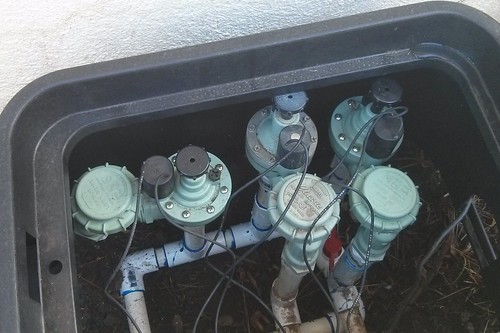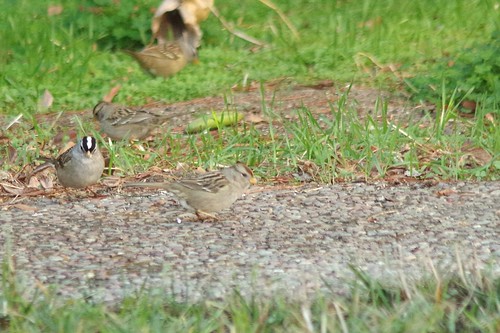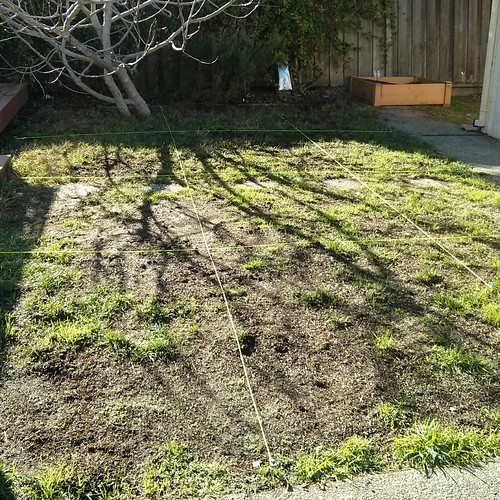Sprinkler valve break and repair
Early last summer, Nathaniel was in the back yard, practicing his kicks into our KixKube. One particularly strong kick missed the cube, and smashed into the exposed sprinkler valves, breaking through the ¾” PVC pipe below one of the valves. The break led immediately to that portion of the garden and lawn being covered in water, so I rushed to close the water main at the street and then scurried to Home Depot to get a PVC cap and fresh (fast setting) PVC cement.
You can see the cap at the right of the above photo; it’s the piece below the blue PVC cement-stained pipe. The fragments of plastic are the remains of the storage container I placed over the valves to protect them from further misses. (Not successfully.)
I decided to make two improvements when I rebuilt this complex: to add a ball valve before the sprinkler valves, so that I can make repairs without turning off water to the entire house, and to add a third sprinkler valve for a drip system. You can see the ball valve underneath the rightmost valve in the picture below; the new valve is the leftmost.
It took a bit of tweaking to get the joints and valves sealed tight, with one or two connections having to be redone. Once I had the valves watertight and the wiring reconnected, my system testing showed that our Rain8 WLM, which was an X10 wireless-based irrigation control, had suffered a power blow-out as well.
Since the Rain8 WLM had been discontinued, I decided to replace the controller with an OpenSprinkler Pi, using WiFi for wireless access. For the X10-based controller, I had built my own set of irrigation programs for cooler, which had been moving from shell scripts invoking flipit driven by cron(1M) to using Redis for state and eventually to a web server model, but I dropped all of that—for now—in favour of Sprinklers Pi running directly on sprinkles (the Pi). With the combination of a regular and a seeding schedule, I have equivalent (or better, with the Weather Underground integration) capability to the previous implementation. The new system has been working well.
Overseeding
With the watering infrastructure restored, I did our fall overseeding, three months late, using a mix of low-water grass and white clover, topped with new soil and compost. These guys—mature and immature white-crested swallows (Zonotrichia leucophrys nuttalli)—showed up once the grass seed hit the ground (and walkway). Let’s hope they leave enough seed to grow. (The mature one is the one sporting the white crest with black stripes on his head.)
This is the second California animal species or subspecies we’ve mentioned here that is named in honour of Thomas Nuttall. (Earlier in the summer, we saw a Nuttall’s woodpecker.)
Weeding by grid
Now that we’ve begun repairing the lawn with new grass, the final phase will be plucking out the crabgrass that dominated one corner. I’m going to work systematically through the lawn using a grid system, plucking out each crabgrass shoot.
There’s about ½” of new soil spread over top to provide new nutrients, but there are also some pretty beaten down bare patches. We’ll see what the spring growth brings.
Next steps
Assuming I establish some level of control over the crabgrass, I’ll connect a small drip irrigation system to that unused valve and introduce a corresponding third schedule to the Sprinklers Pi configuration. If that goes well, I’ll add a second valve to the front lawn for drip—unless we decide that even a small front lawn is an indulgence during a severe drought. (In which case, maybe I’ll transplant the sod from the front to the back and go drip-only in the front to the citrus trees and oleander.)




